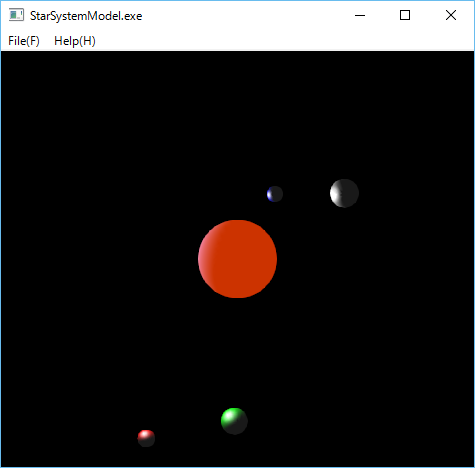4.20 How to render a star sytem model in OpenGL?
In OpenGL, we can also draw a simple start system model like our solar system.
To simpify a story, we assume an imaginary star system which consists of a single sun-like sphere star
and some planet-like spheres rotating on circular oribits around the sun star
, and furthermore, to avoid confusion, we do not care the light direction and reflection light problem of sun and the planets.
We have used the following classes:
OpenGLCircle to describe a circular orbit for the planets.
OpenGLSolidSphere to draw the sun and the planets.
OpenGLTimerThread to move the planets.
The following StarSystemModel is a simple example to draw a star system model.

/*
* StarSystemModel.cpp
* Copyright (c) 2015 Antillia.com TOSHIYUKI ARAI. ALL RIGHTS RESERVED.
*/
#include <sol/opengl/OpenGLMainView.h>
#include <sol/opengl/OpenGLView.h>
#include <sol/opengl/OpenGLGC.h>
#include <sol/opengl/OpenGLLight.h>
#include <sol/opengl/OpenGLMaterial.h>
#include <sol/opengl/OpenGLSolidSphere.h>
#include <sol/opengl/OpenGLCircle.h>
#include <sol/opengl/OpenGLTimerThread.h>
namespace SOL {
class MainView :public OpenGLMainView {
private:
static const int NUMBER_OF_PLANETS = 4;
private:
//Inner class starts
class SimpleView: public OpenGLView {
private:
SmartPtr<OpenGLGC> gc;
SmartPtr<OpenGLSolidSphere> sun;
SmartPtr<OpenGLSolidSphere> planets[NUMBER_OF_PLANETS];
SmartPtr<OpenGLCircle> orbits[NUMBER_OF_PLANETS];
float angles[NUMBER_OF_PLANETS];
SmartPtr<OpenGLTimerThread> timerThread;
int renderingInterval;
float angle;
static const int CIRCLE_ANGLE = 360;
static const int INCREMENT = 1;
CriticalSection criticalSection;
public:
virtual void display()
{
criticalSection.enter();
if (angle <(CIRCLE_ANGLE - INCREMENT) ) {
angle += INCREMENT;
} else {
angle = INCREMENT;
}
static const float INCREMENT[NUMBER_OF_PLANETS] = { 1.0f, 0.7f, 0.5f, 0.2f };
for (int i = 0; i < NUMBER_OF_PLANETS; i++) {
if (angles[i] < CIRCLE_ANGLE - INCREMENT[i]) {
angles[i] += INCREMENT[i];
}
else {
angles[i] = INCREMENT[i];
}
}
if (gc && sun) {
gc -> clear(GL_COLOR_BUFFER_BIT | GL_DEPTH_BUFFER_BIT);
gc -> loadIdentity();
gc -> lookAt(-1.0, 8.0, 17.0, 0.0, 0.0, 0.0, 0.0, 1.0, 0.0);
gc -> clearColor(0.0, 0.0, 0.0, 1.0);
gc -> enable(GL_CULL_FACE);
gc -> enable(GL_LIGHTING);
gc->color(1.0f, 1.0f, 1.0f);
sun-> draw(gc, 0.0f, 0.0f, 0.0f);
OpenGLLight light(GL_LIGHT0);
GLfloat lightPosition[] = {-2.0f, 0.0f, -1.0f, 1.0};
light.position(lightPosition);
for (int i = 0; i<NUMBER_OF_PLANETS; i++) {
Vertex3 pos = orbits[i]->getOrbitPosition(angles[i]);
planets[i]-> draw(gc, pos.x, pos.y, pos.z);
}
}
criticalSection.leave();
}
virtual void resize(int w, int h)
{
if (w == 0 || h == 0) {
return;
}
if (gc) {
gc -> matrixMode(GL_PROJECTION);
gc -> loadIdentity();
gc -> perspective(16.0, (double)w / (double)h, 0.5, 40.0);
gc -> matrixMode(GL_MODELVIEW);
}
}
virtual void initialize()
{
gc = new OpenGLGC();
Color4 black = { 0.0, 0.0, 0.0, 1.0 };
Color4 ambient = { 0.5, 0.5, 0.5, 1.0 };
Color4 diffuse = { 0.2, 0.4, 0.8, 1.0 };
Color4 greendiffuse = { 0.0, 1.0, 0.0, 1.0 };
Color4 reddiffuse = { 1.0, 0.0, 0.0, 1.0 };
Color4 bluediffuse = { 0.0, 0.0, 1.0, 1.0 };
Color4 silverdiffuse = { 0.8, 0.8, 0.8, 1.0 };
Color4 specular = { 1.0, 1.0, 1.0, 1.0 };
Color4 emission = { 0.8, 0.2, 0.0, 0.0 };
GLfloat lowShining = { 10.0 };
GLfloat highShining = {100.0 };
OpenGLMateria sunMateria(GL_FRONT, black, diffuse, black, emission, highShining);
sun = new OpenGLSolidSphere(sunMateria, 0.5f, 40, 40);
int index = 0;
orbits[index++] = new OpenGLCircle(0.0f, 0.0f, 0.0f, 1.0);
orbits[index++] = new OpenGLCircle(0.0f, 0.0f, 0.0f, 1.6f);
orbits[index++] = new OpenGLCircle(0.0f, 0.0f, 0.0f, 2.4f);
orbits[index] = new OpenGLCircle(0.0f, 0.0f, 0.0f, 2.9f);
OpenGLMateria planetMateria1(GL_FRONT, ambient, bluediffuse, specular, black, lowShining);
OpenGLMateria planetMateria2(GL_FRONT, ambient, silverdiffuse, specular, black, lowShining);
OpenGLMateria planetMateria3(GL_FRONT, ambient, greendiffuse, specular, black, lowShining);
OpenGLMateria planetMateria4(GL_FRONT, ambient, reddiffuse, specular, black, lowShining);
index = 0;
planets[index++] = new OpenGLSolidSphere(planetMateria1, 0.10f, 20, 20);
planets[index++] = new OpenGLSolidSphere(planetMateria2, 0.18f, 20, 20);
planets[index++] = new OpenGLSolidSphere(planetMateria3, 0.18f, 20, 20);
planets[index] = new OpenGLSolidSphere(planetMateria4, 0.12f, 20, 20);
timerThread = new OpenGLTimerThread(this, renderingInterval);
timerThread->start();
}
public:
SimpleView(View* parent, const char* name, Args& args)
:OpenGLView(parent, name, args),
renderingInterval(10)
{
for (int i = 0; i < NUMBER_OF_PLANETS; i++) {
angles[i] = 30.0f * i;
}
renderingInterval = (const int)args.get(XmNrenderingInterval);
}
~SimpleView()
{
}
};
//Inner class ends
private:
SmartPtr<SimpleView> view;
long size(Event& event)
{
int width = 0;
int height = 0;
event.getSize(width, height);
if (view) {
view -> reshape(0, 0, width, height);
view -> postResizeRequest(width, height);
}
return 0L;
}
public:
MainView(Application& applet, const char* name, Args& args)
:OpenGLMainView(applet, name, args)
{
int interval = args.get(XmNrenderingInterval);
Args ar;
ar.set(XmNrenderingInterval, interval); //20 millisec
view = new SimpleView(this, "", ar);
}
~MainView()
{
}
};
}
//
void Main(int argc, char** argv)
{
try {
glutInit(&argc, argv);
const char* name = appName(argv[0]);
Application applet(name, argc, argv);
Args args;
args.set(XmNwidth, 640);
args.set(XmNheight, 640);
args.set(XmNrenderingInterval, 20); //20 millisec
MainView view(applet, name, args);
view.realize();
applet.run();
} catch (Exception& ex) {
caught(ex);
}
}
Last modified: 25 Feb 2017
Copyright (c) 2017 Antillia.com ALL RIGHTS RESERVED.
